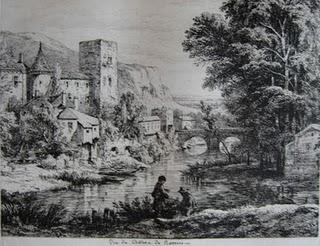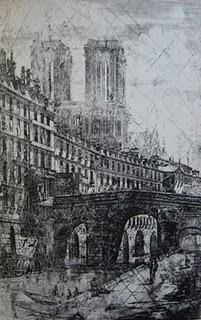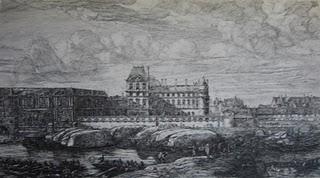 Eugène Bléry, Vue du château de NemoursEtching, 1851
Eugène Bléry, Vue du château de NemoursEtching, 1851I have an interesting pair of Meryon etchings. The first is one of his Parisian scenes, Le Petit Pont. This was actually his first important work, exhibited at the Salon of 1850. My impression is from the cancelled plate. As you can see, Charles Meryon has not been content simply to mark an X from corner to corner, or make a discreet cancellation mark in the bottom lefthand corner. Instead he has attacked the plate with a drypoint needle, scratching a rhythmic welter of diagonal marks across the whole composition, as if he has lashed it with a whip. Ironically, this intended destruction of the piece has not quite worked, as to a modern eye the combination of Canaletto-like calm and expressionistic fury is rather pleasing. Meryon’s Paris seems to be being both destroyed and remade under our gaze. There is an image of the uncancelled plate in this post by John Coulthart at feuilleton.
 Charles Meryon, Le Petit Pont (from the cancelled plate)Etching, 1850
Charles Meryon, Le Petit Pont (from the cancelled plate)Etching, 1850Having put Le Petit Pont beyond use, as he thought, Charles Meryon then turned the copperplate over, rotated it by 90 degrees, and used it to etch my second work, Vue de l’ancien Louvre, after a painting by the Dutch artist Reinier Nooms, known as Zeeman (1623-1667). This interpretative etching was commissioned from Meryon in 1865 by the all-powerful surintendant des Beaux-Arts, M. de Nieuwerkerke, for publication by the Chalcographie du Louvre, and executed the following year. Meryon had already made four etchings after Zeeman as part of his apprenticeship, having been particularly impressed both by Zeeman’s etchings of Paris and his marine sujects. He etched the plate for Vue de l’ancien Louvre directly in front of the painting, holding in one hand the plate and a reversing mirror, and in the other his etching needle.
 Charles Meryon, Vue de l’ancien LouvreEtching after Zeeman, 1866
Charles Meryon, Vue de l’ancien LouvreEtching after Zeeman, 1866It was Meryon’s custom, as we have seen with Le Petit Pont, to cancel his plates after a small edition. In fact he was quite obsessive about this. In the case of the Vue de l’ancien Louvre, however, he was stymied. He marched up to the Louvre to reclaim the plate, and when this was refused flew into a temper and laid about him with his cane. After creating this ruckus, Meryon left in a state of great vexation, while for their part the authorities at the Louvre resolved never to commission work again from such a rowdy and unreasonable character. As a result, the Chalcographie du Louvre contains the only surviving copperplate of Charles Meryon, from which my impressions of the two contrasting sides were printed by Vernant in 1922, in an edition of 605 copies for Byblis. They accompanied an article by Pierre Gusman, “Histoire d’une planche de Meryon”.
The row at the Louvre was evidence of an underlying mental problem; Meryon had from May 1858 spent fifteen months in the asylum at Charenton, and he seems to have suffered from delusions and paranoia. It may be that the sense of order that dominates Meryon’s 102 etchings is evidence of a temperament that was always threatening to explode out of control, and that the excessive violence with which he cancelled the plate of Le Petit Pont shows how strongly an appetite for destruction counterbalanced Charles Meryon’s creative instinct.

